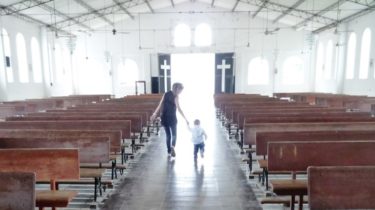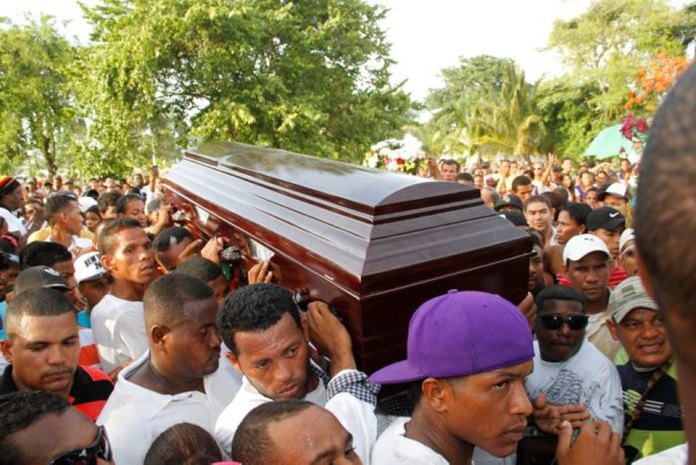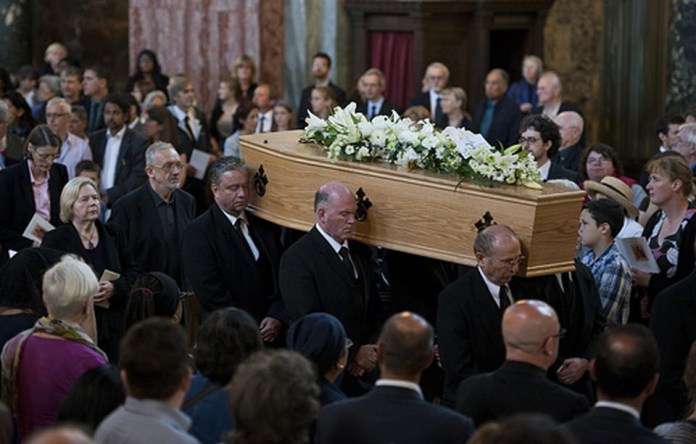Two funerals (and no wedding)

This story first appeared in
Going Local column, The Bogotá Post, 2017
My son reaches up and asks: ‘can I see Papito again?’.
Of course, I say, lifting him high to look down at his grandfather.
‘When will he wake up?’
‘No, mi hijo, he’s dead, I reply.
There is a short silence. ‘Does that mean he is with Grandma?,’ says my son `Yes, possibly,’ I reply, reflecting on the possibility that my just-deceased father-in-law and recently dead mother have at last met at some celestial level, having in life been physically separated by country, culture, language, chronic illnesses and the Atlantic Ocean.
The funerals themselves could not have been further apart.
In Colombia, in the white heat of cloudless day on the Caribbean coast, dressed in our white guayaberos, we gather outside the small house where Papito is lying in an open coffin.
His death was foreseen but the final end comes much sooner than expected. Within hours members of extended family heading to the town from all over Colombia. Here funerals take place within 24 hours, and everyone who can is expected to attend. This means the immediate family have not only to deal with the loss of a loved one, but arrange the church and cemetery at short notice plus receive a huge influx of grieving mourners who need feeding and watering and sometimes housing.
I start to fret that the funeral will turn tragedy into disaster: estranged relatives thrown into close proximity, emotions running high, a hundred hungry mouths to feed, a mad aunt who feels the need to sing Mi Chavela at inappropriate moments, and a body in the living room approaching 40 degrees of tropical swelter.

`Wouldn’t happen like this in England,’ I mutter. And of course it didn’t. My mother’s funeral was a playbook of pre-planned passing with a full two weeks between death and bodily disposal giving ample time for invites invite people, speeches-writing, choosing the music, food and dress code, all the while keeping a stiff upper lip.
Keeping a stiff upper lip
In the south of England, in the grey of late winter, we gather in a chapel in a deserted cemetery with an automated crematorium operated from an electronic console embedded in the lectern. The technology all seems a bit James Bond though I suspect push-button service is more related to reduced staff costs than recreating Diamonds Are Forever.
We carry my dear mother in the coffin, (much lighter than I expect, probably made of MDF, I think) to a conveyer belt inside the chapel while the reverend fiddles with her microphone and some buttons on the console. Choral music springs up. ‘Not that one, that is for the end,’ says my sister who planned the service. The music stops and there is more button pushing and another song starts.
Words are said. A curtain open automatically. The conveyer belt lurches to life and the coffin starts to slide, some music starts, the music stops as the reverend seems to be having problems with the console. The lights dim, change colour, the conveyer belt stops, starts again, more music starts, the curtain starts to close, opens again, the coffin disappears, the curtain closes again, the coffin is gone, it´s all over.
‘That was the wrong music at the end but I don’t think mum would mind,’ says my sister. That night we hold a memorial service at the local church.
Back in Colombia at Papito´s funeral we are still in the house with no apparent plan, though a large quantity of chicken and rice has been doled out which I am surprised the find the crazy singing aunt cooking up in the kitchen. Then with no announcements made the coffin is closed and manhandled down the main street to the church with a phalanx of extended male family moving ahead to block cars while wailing women trail behind.
‘Tropical hardwood’ I think to myself
One of my common moans about Colombian roads is the slow-moving funeral corteges, but now it is me in the thick of it, struggling to keep a sweaty grasp on the heavy smooth casket – tropical hardwood, I think to myself – as the sun beats down. My father-in-law is a deeply religious man who walked this same route many thousands of times in his life. So yes, it now feels deeply appropriate that he makes this same last journey at the same pace he always did. My only worry is we drop the coffin.
At last we swing into the church porch and place the coffin on a trestle, and I am surprised to see no less than five priests sitting behind the altar and the church quickly filling. After the service the coffin will go by hearse to the cemetery, and we must follow.
‘What´s the plan now?´ I ask my wife, anxious we do not get left behind. But before she can answer the hearse pulls away and people start racing towards their cars – for a moment it looks like an old-style foot-race Formula 1 start– so we join the melee and jump the first uncle´s car (there are twenty uncles and even more cars to choose from). Which route are we taking? No-one knows. We somehow get lost but still arrive at the cemetery before the hearse.

Cars pull up, people pour out, and the coffin is carried through the gate. People hug and collapse together in grief, huddled among the white tombs. The murmuring of prayers rises and falls then melds, then unifies, then crescendos, then psalms are said then incanted. There is no script, no plan, no hymn sheet, no order of service, just an improvised mystery play held together by common cause. And now we are in the third act.
Here, as in many parts of Colombia, the dead are placed in concrete tombs that might, or might not, be their final resting places. Family tombs are frequently opened and the mummified remains of a long-dead relative removed, folded up and placed in an osario, a repository for bones that takes less space. So when Papito arrives at the low white concrete bunker a wiry cemetery worker is still sweeping out the remains of a long-dead great aunt from the tomb. This worker then takes a hammer and chisel to chip out bits of the old flagstone that filled the tomb entrance so the new larger coffin can fit in.
Chip, chip, chip. The delay is brutal as we stand with the coffin in the hot sun and the stonemason cleans the tomb entrance, but he cannot be rushed. Chip, chip, chip. The metre of the psalm rises and falls with the stonemason´s chisel. Then the entrance is clear and we manoeuvre the coffin into the tomb.
The stonemason crouches down and starts to slide a large slab of granite over the entrance, family crowd round for their last glimpse of the coffin, some try to poke flowers in the narrowing gap, my wife´s mother collapses against the tomb heaving sobs, the prayers crescendo again, punctuated by wails and cries of sorrow.
Maelstrom of emotions
I am standing in the midst of it, so close I can see the sweat run down the neck of the stonemason as he trowels gobs of cement onto the slab and smooths them in with slow, circular movement. I am fascinated by his slow and precise work, his detachment, a calm eye in a maelstrom of emotions. He could be plastering the garden wall. He takes a step back, gathers his tools in a bucket, and walks off leaving us alone with the sealed tomb.
There is silence now. We stand, heads bowed. A breeze springs up. The heat flows from the afternoon air like water down a drain. I can feel the grief too ebbing, drawn away by the same breeze in a moment of transcendence, then gently replaced with a mantle of sadness. Someone – the singing aunt, I think – passes my wife a small stick snapped from a tree. She crouches down to the tomb entrance and scratches her father’s name in the wet cement. Later, a proper marble headstone will be placed there. But this will do for now.
I think back to my mother´s funeral, and the memorial service. No flowers (my mother was a gardener who could not bear the thought of a living thing cut) but singing, poetry, and well-rehearsed speeches followed by snacks and wine in the vestry. We all try our hardest not to cry (‘I’m so worried I’ll lose it during the service,’ my sister confides).
That then is the crux of it: the raw catharsis of the Colombian coast with its impromptu farewell, or the English adios with every detail – and emotion – under control. Done differently, but in their own way, done right.
